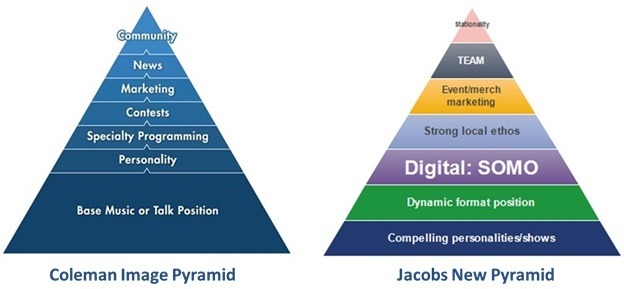Early last month, a post on jacoBLOG called “Pyramid Scheme” introduced the idea of an update or makeover of the original Coleman Image Pyramid. It was based on the premise that radio broadcasters are now competing in an infinitely larger media landscape. The Jacobs New Pyramid suggested a different pecking order, with unique personalities/shows at the base, along with new branding priorities along the way toward the top.
Coleman’s Warren Kurtzman and the Coleman Insights staff were stimulated by the post, and a conversation ensued. On the left is Warren’s response, and on the right, our reactions to his “take.”
These kinds of dialogues are important in these rapidly changing times, so we hope you’ll take the initiative to get involved, and provide your views about broadcast radio’s challenges moving forward. This post appears in both the Coleman and Jacobs blogs today.
Fred,
My Coleman Insights colleagues and I loved your February 4th blog about adapting our Image PyramidSM for the increasingly complex competitive marketplace radio stations face. The Image Pyramid has always been a “living, breathing” idea—in fact, the graphic you used to present it is a brand new version we created about a year ago—and we welcome any and all efforts to help its evolution, especially by people we view as fellow thought leaders for our industry.
If there’s a theme that came across in your blog that resonates with us more than anything else, it is the value of brand depth. This is something that we’ve been preaching to our clients long before competition from iPods and streaming were on anyone’s radar; radio stations that have been seen as more than jukeboxes and that listeners associated with other programming elements such as personality, contesting, etc., have always been the ones most likely to enjoy long term success and engender consumer loyalty.
The value of brand depth was true 20 years ago and it’s even more vital today. Recently, one of my colleagues was moderating focus groups with 17- to 28-year-old fans in which almost every participant regularly turned to streaming on their mobile devices for music consumption. However, every one of these respondents used local radio—with its lack of customization and its commercials—because of how its personalities and other nonmusical elements complemented the curated music mix the station delivered. Specifically, this client’s morning show had evolved to the point that it became “can’t miss” entertainment for its digitally-engaged audience.
We also concur with your thoughts about examining radio stations from a broader perspective that goes beyond a “Radio vs. Radio” view of the world. Depending on the needs and goals of our clients, our studies often include respondents who are not significant radio consumers, but who—because of other attributes, such as their interest in particular types of content—should absolutely be part of our clients’ target audiences. That said, there is no hard and fast rule here; sometimes strategies should be based on the broader marketplace and other times focusing on the Radio vs. Radio competitive landscape makes more sense. The key is to make sure that you look at the broader “Radio vs. Everything” world on a regular basis to avoid radio tunnel-vision. That has become a larger and larger part of our business over the years.
While there are a lot of parallels between what we’ve espoused via the Image Pyramid and your recent post, we think the readers of our respective blogs would benefit from a discussion of how to use our philosophy in sync with your ideas. Of course, that may lead to a few places where our ideas clash, which hopefully will make for some entertaining and informative reading!
We think an important thing for our collective audience to understand is that the Coleman Insights Image Pyramid is about managing brand and image development. It says that in an ideal world, if a music station’s listeners were gathered together and asked to name what first comes to mind when they think of the station, they would first be able to describe the kind of music the station stands for, followed by the personalities on the station who they enjoy, the special programming elements the station offers (e.g., a morning show feature or a weekend show that departs from the station’s usual format), etc. as we work our way up the pyramid. The idea is that until a station first builds imagery for the bottom layer, it should devote as many of its resources as possible—including marketing dollars, the time and energy of its managers and on-air messaging—to completing that process before it works on the next layer above it.
The pyramid you propose consists of sound operational advice and is therefore designed for a somewhat different purpose. For example, like you and your colleagues, we are huge advocates of using digital tools like social and mobile, but not so much for the development of digital imagery. Instead, we push our clients to use “SOMO” to facilitate the development of the images called for in the Image Pyramid, such as how a morning show can incorporate Instagram into their efforts at growing their image for entertainment value or how a station’s mobile app can enhance its contesting imagery. The same goes for local ethos, which we encourage clients to tie into personalities, contesting, marketing, news and information and—of course—community involvement.
In other words, your pyramid covers tools and tactics that we believe every station should employ if it is serious about competing in the Radio vs. Everything world. It does not, however, replace the brand development goals that we continue to see drives the success of most leading radio stations.
Warren,
Thanks for providing Coleman Insights’ reactions to our pyramid conversation.And in reading your comments, I think it’s clear that we’re reading out of the same branding hymnal, but perhaps we’re on different pages.
Your assertion that brand depth has been a driving issue for radio is spot on. Too often, stations have attempted to get by with a well-tested “safe list” of songs with very little else. While many of these stations have excelled in the ratings, their success may be more of a statement about the illusion and relative ease of “inside radio” competition.
In a world where satellite radio, personal music collections, YouTube, and “pure plays” enter the fray, radio’s over-reliance on staking out a musical position and doing very little else just won’t cut it. (We may already be seeing this playing out in real-time with the Classic Hip-Hop format.)
We continue to see the same phenomena as you – in our focus groups and Techsurveys – entertaining, community-oriented personalities and hosts matter in virtually every format. In order to compete in an environment of seemingly infinite options – and not just other local stations – a stronger priority on developing and nurturing talent has moved to the top of our list – or in this case, the bottom of the pyramid.
The SOMO (social/mobile) part of our pyramid isn’t just about building digital imagery. Brands are now being made – or broken – on social media. A great radio station without a strong mobile strategy will find itself increasingly edged out of conversations and usage. It is no longer possible to build great brands without strategic digital initiatives in place that connect a changing culture.
Then there’ the revenue piece. As the RAB unveils its 2014 revenue numbers industry-wide, it becomes more apparent that digital isn’t just where consumers are moving – advertisers are running right along with them.
That brand depth you speak about is we continue to marvel at how prescient your original pyramid was when it first was developed in the ‘90s. We believe that multiple perspectives and strategies are needed now.
So maybe the answer is that both pyramids should be tacked up on office and cubicle walls. The original Coleman Image Pyramid serves radio brands well as they fight the good fight in the local ratings war. And the Jacobs New Pyramid is a catalyst to remind ourselves that the battleground has expanded exponentially.
Radio programming and brand building just got more challenging. Every programmer feels it as smartphones, social media, pure-plays, and personal playlist services continue to grow and expand. Now looking both ways – at the Coleman Image Pyramid locally and the Jacobs New Pyramid globally – helps frame what brand building is all about in 2015.
- Media And Technology In 2025: Believe It Or Not! - April 18, 2025
- In Radio, You Just Never Know - April 17, 2025
- The Secret To Making A Great Podcast (And Great Radio) - April 16, 2025







What I have always appreciated about the Coleman pyramid is that while music is the “base,” the bulk of the pyramid is “the other stuff.” Perhaps that isn’t what was ever intended by an industry that loves stringing songs together, but it is truth.
The reason the Jacobs model makes much more sense is that it acknowledges that the tangible heart of a radio station is the people and the programming. Audiences are increasingly looking for their devices to DO something. Be interesting, be entertaining, be informative. Any mope can lay there and play songs.
Sadly, the Coleman pyramid has been used (and abused) by those antiquated programmers who still see us as a jukebox.
And in fairness, Johnny, you’re correct that the Coleman Pyramid has been abused over time. The Coleman folks have always been strong proponent of building strong brand assets. Our New Pyramid hopefully raises the bar a bit, urging stations to hire/develop/nurture/train/recruit talent that can help make brands unique and must-hear. Thanks for taking the time to comment.
One could argue that no matter which pyramid model you choose, unless you build the ENTIRE structure, both are flawed and incomplete. There are plenty of “unfinished” pyramids across the radio landscape, regardless of owner or market size.
Sad but true, Jerry. And it’s challenging to find stations that hit it out of the park in all these dimensions. But the need to prioritize is something that was reinforced to me the first time I saw the Coleman Image Pyramid. And we tried to incorporate the need for a brand hierarchy in our pyramid. Thanks for taking the time to weigh in.
Yours has inspired, Fred. Thanks for posting.